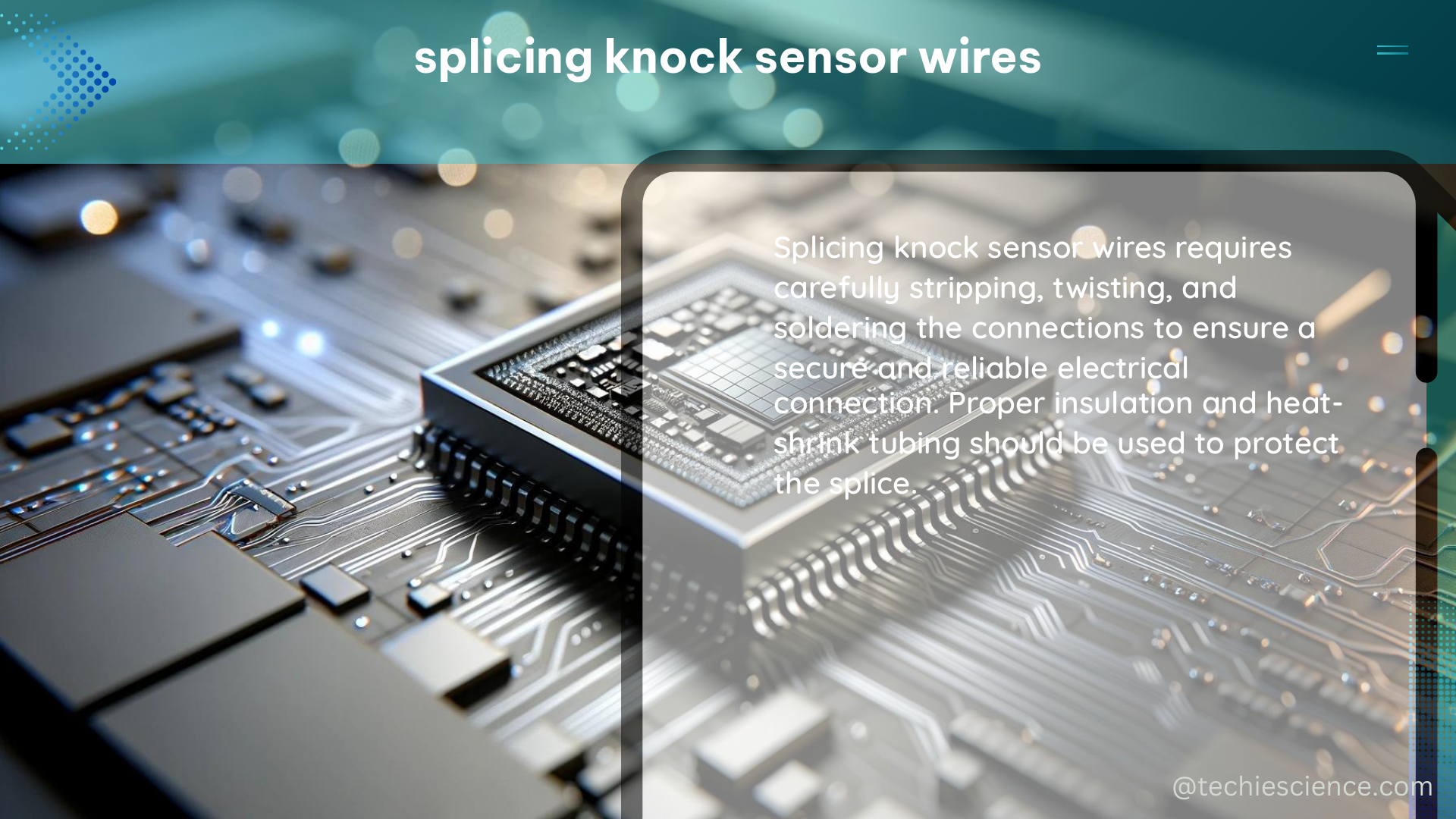Splicing knock sensor wires is a common repair method for diagnosing and fixing engine misfires or poor performance. The resistance and voltage of the knock sensor wires are critical measurements that can help identify any issues with the sensors or wiring. This comprehensive guide will provide you with the technical details and step-by-step instructions to properly splice knock sensor wires.
Understanding Knock Sensor Wiring
Knock sensors are essential components in modern engines, responsible for detecting engine knocking or detonation. They work by measuring the vibrations or pressure waves generated by the engine’s combustion process. The knock sensor wires transmit this information to the engine control unit (ECU), which then adjusts the ignition timing to prevent engine damage.
The recommended resistance for a knock sensor connector pin to the engine block is typically around 98 ohms, but this value can vary depending on the make and model of the vehicle. It’s crucial to consult the vehicle’s service manual to determine the specific resistance value for your application.
Preparing for Splicing Knock Sensor Wires

Before you begin splicing the knock sensor wires, ensure that you have the following tools and materials:
- High-quality wire strippers and crimpers
- Dielectric grease
- Heat-shrink tubing or electrical tape
- OEM or high-quality aftermarket knock sensor and wiring harness
It’s essential to use OEM or high-quality aftermarket components when splicing knock sensor wires. Using low-quality sensors or wiring harnesses can result in intermittent or false codes, leading to unnecessary repairs.
Step-by-Step Guide to Splicing Knock Sensor Wires
-
Locate the Knock Sensor Wiring Harness: Identify the location of the knock sensor wiring harness, which is typically located near the engine block or cylinder head.
-
Disconnect the Knock Sensor Connector: Carefully disconnect the knock sensor connector from the wiring harness, ensuring that you don’t damage the connector or the wires.
-
Inspect the Wiring: Visually inspect the knock sensor wires for any signs of damage, such as fraying, cracking, or corrosion. If the wires are in good condition, proceed to the next step.
-
Measure the Resistance: Use a multimeter to measure the resistance between the knock sensor connector pin and the engine block. The resistance should be around 98 ohms, but refer to the vehicle’s service manual for the specific value.
-
Prepare the Wires for Splicing: Using wire strippers, carefully remove a small section of the insulation from the knock sensor wires, exposing the bare copper conductors.
-
Splice the Wires: Twist the exposed copper conductors together and secure them with a high-quality crimp connector. Ensure that the connection is tight and secure.
-
Apply Dielectric Grease: Apply a generous amount of dielectric grease to the crimp connector and the surrounding area to prevent moisture and corrosion from affecting the connection.
-
Secure the Splice: Wrap the splice with heat-shrink tubing or electrical tape to provide additional protection and strain relief.
-
Reconnect the Knock Sensor Connector: Carefully reconnect the knock sensor connector to the wiring harness, ensuring that it is securely fastened.
-
Test the Knock Sensor Wiring: Use a multimeter to measure the voltage of the knock sensor wires. You should see a small AC voltage (typically around 0.5-2.5 volts) when tapping around the sensors. If no voltage is detected, it’s likely that both sensors are faulty, which is an extremely unlucky scenario.
Troubleshooting Knock Sensor Wiring Issues
If you encounter any issues with the knock sensor wiring, such as intermittent or false codes, consider the following troubleshooting steps:
-
Verify the Resistance: Double-check the resistance between the knock sensor connector pin and the engine block. If the resistance is significantly different from the recommended value, the sensor or wiring may be faulty.
-
Check for Loose Connections: Ensure that the knock sensor connector is securely fastened to the wiring harness and that there are no loose connections.
-
Inspect for Damage: Carefully inspect the knock sensor wires and connectors for any signs of damage, such as fraying, cracking, or corrosion.
-
Replace the Knock Sensor: If the resistance and voltage measurements are within the expected range, but you’re still experiencing issues, the knock sensor itself may be faulty and require replacement.
By following this comprehensive guide and troubleshooting any issues that arise, you’ll be able to successfully splice knock sensor wires and maintain the proper operation of your engine’s knock detection system.
References:
- Club Lexus Forum – P0330 Knock Sensor 15 Min Hack Repair
- Club Xterra Forum – Knock Sensor Relocation Question – Splicing
- Matthews Volvo Site Forum – Splicing into a Sensor Ground – What is the Best Way?
- HP Academy Forum – Splicing into a Sensor Ground – What is the Best Way?
- LS1Tech Forum – Still Have P0332 After Replacing Both Knock Sensors & Wiring Harness

The lambdageeks.com Core SME Team is a group of experienced subject matter experts from diverse scientific and technical fields including Physics, Chemistry, Technology,Electronics & Electrical Engineering, Automotive, Mechanical Engineering. Our team collaborates to create high-quality, well-researched articles on a wide range of science and technology topics for the lambdageeks.com website.
All Our Senior SME are having more than 7 Years of experience in the respective fields . They are either Working Industry Professionals or assocaited With different Universities. Refer Our Authors Page to get to know About our Core SMEs.